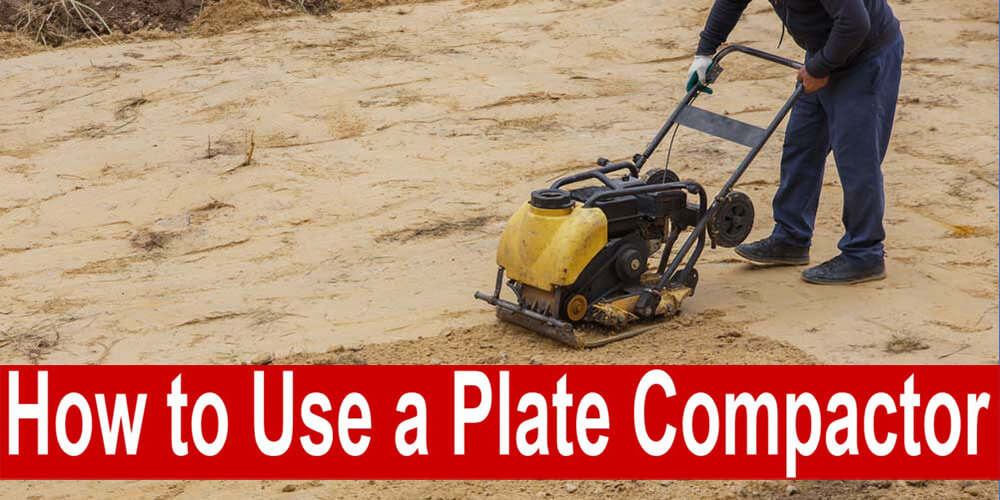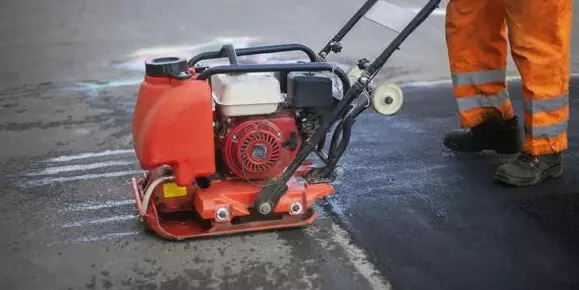07Jun 2023
table of contents
Before building your structure, you must consider having a stable subsurface, and one way of doing this is with a plate compactor. Plate compactor can compacts your subsurface, covering gravel, sand, and dirt etc.
Learn the proper way to operate a plate vibratory compactor to ensure efficiency, safety and optimal results.

Proper compaction is essential for ensuring the structural stability and durability of a project. It enhances stability, increases shear strength, reduces compressibility, improves moisture control and enhances load-bearing capacity. By eliminating voids and increasing soil density, compaction prevents settling, settling and structural damage over time.
Plate compactors, also known as vibratory compactors, use a simple yet effective mechanism to achieve compaction. These machines feature heavy-duty steel plates that exert downward force on the surface. When the plate vibrates rapidly, it creates momentum that helps settle and compact the soil or aggregate underneath.
BISON believes that always check the manufacturer's manual to ensure all parts are complete. Familiarize yourself with the compacting machine's controls and check for necessary precautions that could prevent the vibrating plate compactor from working. Also, check your work environment for any obstructions that could cause damage to the compactor.
Check the tightness of bolts and nuts. Bolts that are not held securely can cause the threads to loosen, which can cause damage when vibrating.
Check the oil tank. Always make sure the engine is not running and must be in a stable position before doing this. See the manual for recommended oil level and type. Refrain from filling, as it may cause leakage.
Check the fuel tank. As with the fuel tank, visually check that the fuel is at the level recommended in the manufacturer's manual. When filling, always ensure the engine is not switched on and should not overheat, let it cool first. If a spill occurs, wipe it dry and never turn on the machine until completely dry.
Inspect the air cleaner and filters for dirt and dust. Always clean and replace the filter if necessary. It is worth mentioning that BISON not only supplies plate compactor machine, but also independent packaging services for accessories corresponding to the style.
Step 1: Wear critical eye and hearing protection.
Step 2: Lever the gasoline valve open. After that, set the throttle lever to idle or a speed between high and low. Put the choke lever in the open position right now.
Step 3: Grab the starter handle and pull it up slowly. Avoid pulling the rope to the end; never unwind it quickly and let it rewind. When the engine starts, let go of the starter handle and allow it to kick back.
Step 4: When the engine starts, check for any leaks, unusual noises and smooth running. You can now move the throttle stick to the run position.
Step 5: Push the handlebar and steer the earth compactor to your desired position. Carefully move it forward or backwards to level your surface. Grab the handle firmly and transfer it to your desired position.
Plate compactors are sometimes slow, but this may be for different reasons. One possibility is that clay or similar material was left on the plate. Another factor is the high moisture content of the compacted soil.
Choosing BISON plate compactor is not only about small engine type, the type of subfloor to be compacted, concrete plate compactor area but also compacted soil type.
Gravel compaction
Gravel is loose crushed stone that, like sand, has no cohesion. You should also keep in mind the size of the gravel. The larger the rock to be broken, the larger the plate compactor should be for higher productivity.
Considering the gravel's size, prepare your excavation site, ensuring it does not overlap your finish line once compacted.
Add a few inches of gravel; wetting it will help, then start compacting the first layer of gravel.
Check the first layer's firmness; once stable enough, add more gravel layers and compact.
Check the level of the gravel bed until the desired thickness and level are achieved.
When you're done, sweep away the excess.

Dirt compaction
Dirt is a mixture of inorganic and organic matter, some producing moisture.
Separate the dirt and check for foreign objects that could damage the plate.
Use BISON plate compactor start compacting in a straight line until all the dirt is compacted.
If some water is present, the moisture can help tighten the dirt by filling the air pockets without leaving loose spaces.
Pedal on the dirt surface and check that it is stable enough; pedal as much as possible to get the desired surface firmness.
When you're done, clean any dirt stuck to the plate.
Soil compaction
Soils are divided into three categories: sandy, silt, and clayey. Sandy soil is rough, so it feels gritty with your fingers. They need to be more cohesive and tend to crumble when picked up. Clay is smooth and denser, which means it is stickier when water is present.
Add soil to the area and start misting with water. Avoid splashing too much water, as it will become sticky and harder to pack. You can install a low nozzle on the hose.
Take a short break to let the water penetrate the soil.
Once the ground has absorbed the water, keep watering until the desired level of moisture is reached.
Now, use BISON plate compactor start plate compaction equipment in a straight line, going through all corners of your site. Always check that your soil is sufficiently moist.
Check the soil for firmness and compactness until desired stability is achieved.
When you're done, avoid other activities in the area and wait for it to dry.
Plate compactors are powerful tools used in paving and construction projects to compact asphalt and soil. However, it can be even frustrating when the plate compactor starts sticking to the asphalt surface, making moving difficult and causing projecays.
Here are some helpful tips and tricks for keeping your plate compactor from sticking to asphalt:
Make sure the slab compactor is clean: Before starting a project, verify that the slab compactor is clean and free of debris. Any dirt or debris on the plate will make it stick to the asphalt.
Use a release agent: A release agent is a substance applied to the asphalt surface to prevent the plate from sticking. Many release agents are available, including wax- and water-based release agents.
Adjust the water level: The plate may get stuck if the asphalt is too wet. To prevent this, ensure the asphalt has the proper moisture content. If the asphalt is too dry, water can be added to the surface for optimum humidity.
Use proper compaction method: To avoid sticking slab compactors, it is critical to use proper compaction technique. When compacting the asphalt, according to the manufacturer's recommendations, use a suitable amount of force on the plate compactor.
Check the temperature: If the asphalt is too cold or too hot, the boards may stick. Do not use boards outside the recommended asphalt temperature range.
Following these tips can prevent rollers from sticking to the asphalt and keep your construction or paving project running smoothly.
To ensure you choose the correct and right type of plate compactor, you need to consider several different factors:
What kind of ground material are you compacting: solid or granular?
What material are you laying on turf, pavers, or something else?
Each model of the plate has a force rating called centrifugal force. Higher ratings provide greater compaction power. If the material you are using requires a lot of force to compact, check the rating of the compactor plate you will use to ensure it works effectively. Too much centrifugal force, and you'll destroy the work you've already done. Too little centrifugal force and you won't be able to get the job done.
To compact the pavers, use rubber mats next to the compactor deck.
Granular ground requires a higher vibration frequency, while solid ground requires a lower frequency.
The width of the plate also plays a simple but important role. Wider boards cover more ground at once.
The weight of the machine also plays a role in this process. Plate compactors vary in weight from 45kg to 500kg. Generally speaking, the more complex the ground material, the harder it is to compact, so you'll need a heavier compactor.
If you're done with BISON plate compactors, put the throttle on idle first. Let the engine run at low speed for a few minutes. Now shut off the engine and close the fuel lever. After use, ensure the plate is clean and free of dirt or foreign objects. To prevent rust and prolong the life of your plate, store it covered and in a clean, dry place.
BISON plate compactor also is the smart choice for compaction projects. Consider using different types of plate compactors to achieve the correct compaction for the different subsurfaces of your project. Through the vibration of the plate compactor, the material consolidates, removes air pockets and finally stabilizes at the desired level. With all this different information, to choose the best option for a plate compactor to achieve the desired compaction.
inquiry form here
BISON BLOG, All the latest news and views from Bison Machinery.